Amidst the hustle and bustle of our modern lives, there’s a tranquil world where creativity and comfort come together – the world of quilting. While you might associate quilts with estate sales and county fairs, quilting is a timeless craft that welcomes people of all ages to explore their artistic side and experience the cozy embrace of a handmade quilt. Quilting isn’t just about sewing fabric; it’s an age-old tradition with deep historical roots, an expressive art form transcending language, and a fulfilling hobby that brings therapeutic joy.
From its humble origins in ancient Egypt and China to its central role in American pioneer life, quilting has been both practical and artistic. Modern quilters continue this tradition today, fusing the practicality of quilts with innovative designs and personal expression.
This article will introduce you to everything you need to know to start quilting. Whether you’ve sewn garments, want to explore quilts, or are new to sewing, this article will guide you to success. We’ll include our favorite patterns, online quilting communities, and more!

How to Start Quilting?
Quilting, a craft that seamlessly combines artistry and practicality, necessitates a specific set of tools and materials to embark on your journey successfully. Whether you’re just starting or are already an experienced quilter, having the right equipment is essential to ensure the beauty and functionality of your quilting projects. Here, we’ll explore the tools and materials required to begin your quilting adventure.
Essential Tools and Supplies You Need
To create a well-equipped quilting space, gather the following essentials:
Quilting Sewing Machine
A good-quality sewing machine is the backbone of quilting. While you can make quilts on a regular sewing machine, a quilting-specific sewing machine will have a larger table to keep your fabric flat and even. Look for a machine with adjustable stitch length and a quilting or walking foot attachment for even stitching.
Ensuring your sewing machine has adjustable stitch length allows you to customize your stitches to suit different aspects of your quilting project, from piecing the quilt top to quilting the layers together. The quilting or walking foot attachment is essential for evenly feeding multiple layers of fabric, batting, and backing through the machine, preventing puckering or misalignment in your quilting lines.
Needles and Thread
Invest in quilting-specific needles and high-quality cotton thread in various colors for your sewing machine. The suitable needles and thread will ensure smooth and secure stitching.
Quilting needles are designed to pierce through multiple layers of fabric and batting with ease, reducing the risk of skipped stitches or fabric damage. When selecting thread, opt for high-quality cotton thread, as it possesses both strength and durability. An assortment of colors allows you to match or contrast your fabric choices, adding depth and texture to your quilt designs.
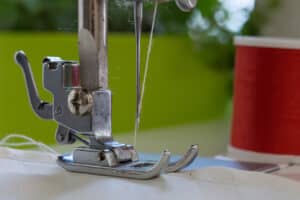
Ruler and Measuring Tools
Precision is key in quilting. A transparent acrylic quilting ruler, measuring tape, and a 45-degree rotary cutter are indispensable for accurate cutting and measuring.
The quilting ruler provides precise measurements and straight edges, making it ideal for accurately cutting fabric strips, squares, and triangles. The measuring tape ensures that your quilting project maintains consistent dimensions throughout, producing a professional finish. A 45-degree rotary cutter allows you to cut fabric at perfect angles, create intricate designs, and piece blocks together seamlessly.
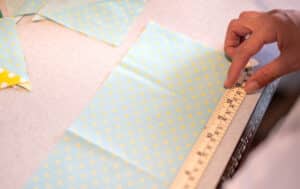
Pins and Pin Cushion
Quilting pins with flat heads and a pin cushion keep your fabric layers together during assembly without causing snags or distortion.
The flat-headed quilting pins are designed to hold fabric layers securely in place without damaging the material. A pin cushion, often worn on the wrist or placed within easy reach, keeps your workspace organized and your pins readily available as you piece together your quilt top.
Fabric Selection and Types
In quilting, your choice of fabric plays a pivotal role in your quilt’s overall look, feel, and durability. Here are several types of fabrics commonly used in quilting, each with its unique characteristics:
Cotton
Cotton fabric is the quintessential choice for quilters. It’s renowned for its softness, breathability, and ease of sewing. Cotton quilting fabrics come in a vast array of prints, patterns, and solids, making them suitable for a wide range of quilt styles, from traditional to modern.
Polyester
Polyester fabrics are known for their durability and resistance to wrinkles and fading. While less breathable than cotton, polyester blends can add strength to quilts and are often used for projects that require extra resilience.
Flannel
Flannel is a cozy and warm fabric choice, making it ideal for quilts intended for colder weather or snuggling. Its soft, brushed surface adds comfort and a touch of rustic charm to quilts.
Linen
Linen fabrics have a distinctive texture and natural appearance. Linen can lend a rustic and vintage look to quilts, adding character and depth to your design.
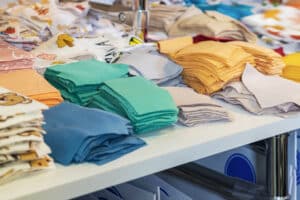
Cutting Tools and Mats
Precisely cutting your fabric is essential to a polished finished piece. Here are the tools that should make the cut:
Sewing Scissors
Sewing scissors are versatile cutting tools that come in various sizes and shapes. They are perfect for trimming threads, cutting fabric along curves, and performing detailed work. Look for scissors with sharp, stainless steel blades that maintain their edge even with frequent use.
Scissor Sharpener or Honer
A scissor sharpener or honer is an indispensable tool for keeping your sewing scissors in optimal condition. Regularly honing your scissors ensures they stay sharp, making your cutting tasks more efficient and precise. Well-maintained scissors help prevent fabric fraying and uneven edges in your quilting projects.
Rotary Cutter
A rotary cutter is a game-changer in quilting, providing straight, clean cuts with minimal effort. It consists of a circular blade that rotates as you cut, resulting in smoother edges and faster fabric cutting. When choosing a rotary cutter, consider one with safety features such as a blade guard and an ergonomic handle for comfortable use.
Cutting Mat
A self-healing cutting mat is vital for protecting your work surface and extending the life of your cutting blades. These mats are designed to “heal” or close up after each cut, ensuring a smooth and stable surface for precise cutting. Available in various sizes, a large cutting mat provides ample space for cutting fabric strips, squares, and blocks without the risk of damaging your table or dulling your blades.
Batting and Backing Fabrics
A quilt is essentially a fabric sandwich – the top fabric, the batting, and the backing fabric. Here’s what you need to know about the two.
Batting
Batting, also known as wadding, forms the quilt’s inner layer, providing insulation and determining its thickness. It comes in materials like cotton, polyester, and wool, each offering unique qualities. Cotton is breathable and ideal for warm-weather quilts, while polyester is lightweight and moisture-resistant, giving a fluffy look. Wool batting provides exceptional warmth and moisture-wicking properties, resulting in a lofty texture.
Additionally, the loft, referring to thickness, can be low for lightweight quilts or high for a pronounced effect suitable for winter. The quilting density, or spacing between stitches, also influences the quilt’s appearance and warmth, with closer lines creating a smoother surface and wider spacing, resulting in a loftier texture. Your choice depends on your preferred style and intended use.
Backing Fabric
Backing fabric, the quilt’s bottom layer, enhances the visual appeal of the reverse side. Typically made of durable quilting cotton, it offers a wide array of colors and patterns to complement your quilt top. Some quilters choose cozy materials like minky or flannel for added comfort.
Ensure the backing fabric is larger than your quilt top on all sides, allowing for seam allowances and full coverage. When joining multiple pieces for the backing, consider placing the seams horizontally to prevent stretching or distortion during quilting.
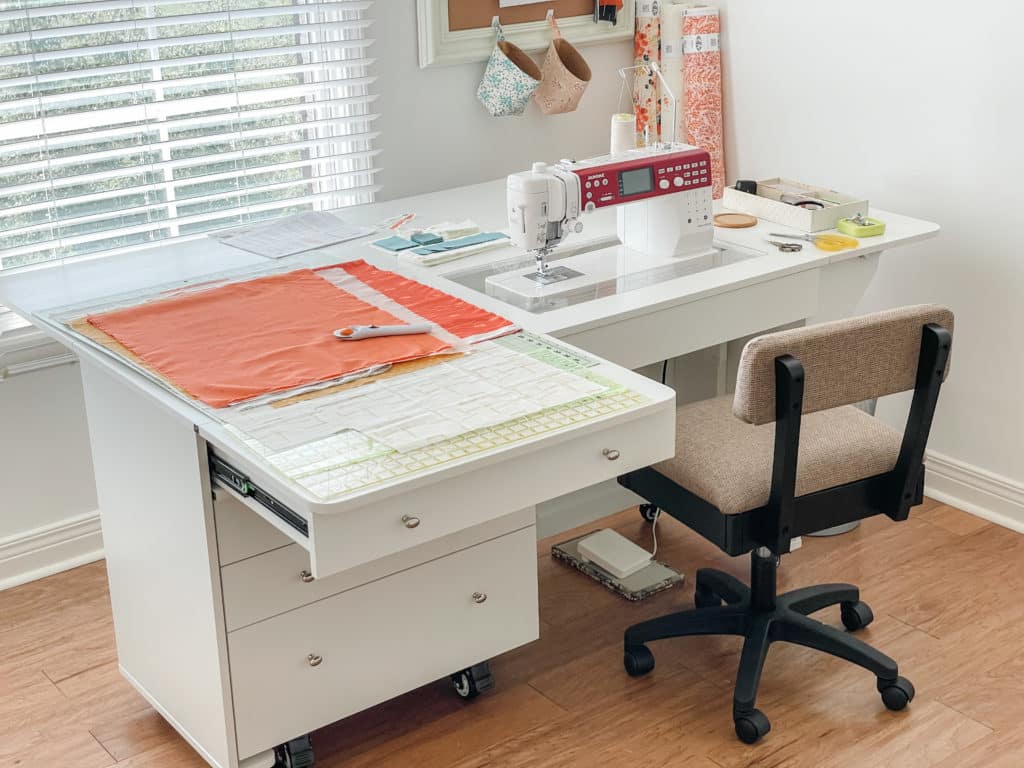
Setting Up a Quilting Workspace
Establishing an efficient and inspiring quilting workspace is essential for any quilting enthusiast. Start by selecting the right sewing cabinet or table that suits your needs. A well-designed quilting workspace provides the ideal foundation for your creative endeavors. Consider the size and layout of your quilting space to determine whether a spacious sewing table or a compact sewing cabinet is more suitable.
Arranging Your Materials
Efficient storage is vital to a productive quilting space. Invest in practical fabric storage systems that keep your materials organized and easily accessible. Having your fabric neatly arranged enhances your workspace and streamlines your quilting projects. Utilize storage solutions that categorize fabrics by color, pattern, or project, making it a breeze to find the perfect piece for your next creation.
Also, utilize a thorough thread storage system in your workspace. As you accumulate spools of thread, being able to see them all at a glance will make you a more efficient quilter.
Proper Lighting
The importance of proper lighting cannot be overstated in quilting. Adequate illumination ensures you can see your work clearly and make precise stitches. Consider installing task lighting around your sewing cabinet or table to eliminate shadows and reduce eye strain during long quilting sessions. Good lighting also enhances the accuracy of fabric selection, ensuring that colors and patterns align seamlessly in your quilts.
Adequate Ergonomic Support
Quilting can be a labor-intensive craft, often involving hours of stitching and cutting. Invest in an ergonomic sewing chair designed to support your posture and reduce stress on your back and neck to minimize the risk of discomfort or strain. Your quilting projects will benefit from your comfort and focus when you have the right chair to support you.
Organizing Your Quilting Space
Maintaining an organized quilting space is an ongoing process. Incorporate storage solutions, such as shelving units, drawers, and thread organizers, to keep your supplies within reach. Create designated cutting, sewing, and pressing areas, ensuring that each step of the quilting process has its dedicated space. An organized workspace boosts your efficiency and enhances your overall quilting experience.
Develop Your Skills with Essential Quilting Books for Beginners
- Teach Me to Make My First Quilt by Pat Sloan: The “teach me” series of craft books is immensely popular, and for good reason. These books have great diagrams and easy-to-understand instructions that make quilting accessible to anybody.
- The Beginner’s Guide to Quilting by Elizabeth Betts: If you learn by doing, this book is best for you. The author guides you through 16 projects of varying difficulty, all intended to grow your quilting skills. You’ll end up with some beautiful pieces for your home!
- No Scrap Left Behind by Amanda Nyman: Fabric scraps are integral to the art of quilting. Knowing how best to use small lengths of fabric for your projects will serve you well as you continue to quilt.
- First-Time Quiltmaking by Landauer: This book assumes you know nothing about sewing, quilting, or using a sewing machine. If you’re a total beginner to the craft, this is the best guide for you.
- The Modern Quilt Bible by Elizabeth Betts: If you only buy one book about quilting, make it this one. This veritable tome not only teaches you how to quilt but serves as an encyclopedia of different techniques for quilters of all skill levels.
Quilting Classes for Beginners
While books are a valuable resource for beginner quilters, you may want more specialized guidance as you hone your skills. Luckily, a wealth of quilting classes are available both online and in real life.
To find in-person classes, hang around your local fabric shop or sewing machine repair store. These specialized shops often offer classes for sewists of all levels, and you can meet a network of quilters to learn from and sew with. If your local fabric shop doesn’t offer classes, ask the staff if they know anyone in town who can teach you.
If you’re more of a homebody, online quilting classes are perfect for you. These classes allow you to move at your own pace and personalize the lessons you watch, and you can always return to them for a refresher. You may opt for a free quilting course on YouTube or Quilt Addicts Anonymous or pay for classes from Skillshare or Creative Bug.
Another advantage of seeking out quilting classes is the opportunity to build a community of quilters. By visiting a fabric store regularly, you may find a sewing circle or quilting group that meets weekly or monthly. Also, seek out quilting-centered communities online – Pinterest, Reddit, and Tumblr all have thriving quilter communities that are welcoming to beginners and advanced quilters alike.
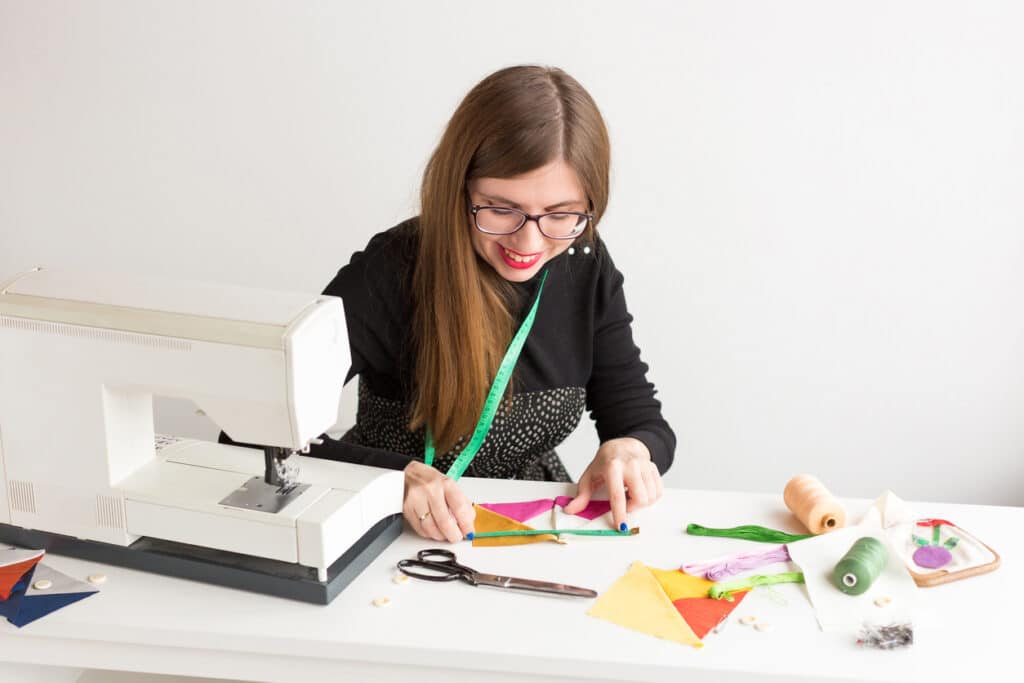
Easy and Simple Quilt Patterns for Beginners
When starting as a quilter, it’s easy to choose flashy and fascinating designs. However, trying out a project above your skill level can result in more frustration than fulfillment. Here are a few of our favorite quilting patterns for beginners:
- Zig Zag Quilt: This deceptively simple quilt is made with charm packs, so you can mix and match your colors to suit your tastes.
- Hexagon Quilt: If you want to practice cutting your fabric into shapes other than squares and rectangles, this is the pattern for you. Fat quarters are cut and joined to form this geometric quilt.
- Big Heart Quilt: This square quilt makes an excellent baby blanket or lap blanket. Utilize spare charm packs to make a patchwork heart.
- Jelly Roll Jam Quilt: This won’t be the last time you run into jelly rolls! Jelly roll quilts are fun, creative, and colorful; this pattern is no exception.
- Easy Puff Quilt: The puff quilt may seem intimidating, but it’s easier than it looks. This technique is fun and whimsical and works quickly.
- Quick Swiss Cross Quilt: If you love minimalistic quilt patterns, this one is right up your alley. If you’re familiar with quilting techniques, you could work this up over the weekend.
- Tiny Tile Quilt: Do you have a basket full of fabric scraps you’re unsure what to do with? Turn them into tiny tiles! This pattern is excellent for honing your cutting skills.
- Retro Plaid Quilt: Many of us got into quilting because of the beautiful blankets our grandmothers made. Well, now it’s your turn to make a retro quilt! This pattern is fun, straightforward, and accessible.
Quilting is more than just a hobby; it is a way of life. Once you feel comfortable with your sewing machine and storage setup, start getting creative with patterns and see what you can produce. Whether you’re a seasoned quilter or just starting, remember that every stitch tells a story, and every quilt is a masterpiece waiting to be born. So, thread your needle, pick your fabrics, and let your imagination run wild as you craft quilts that warm the heart and tell tales of a life well-lived. Enjoy the journey!
Once you’re ready to set up the quilting room of your dreams, trust the sewing experts at Arrow Sewing. We offer a wide variety of specialized furniture designed by sewists for sewists. Whether you need an all-in-one table and storage system or an ergonomic chair with storage, we’ve got what you need. Check out our product catalog today!
